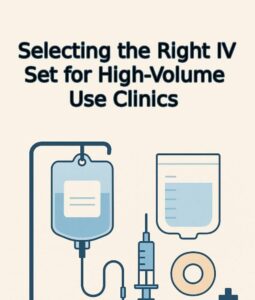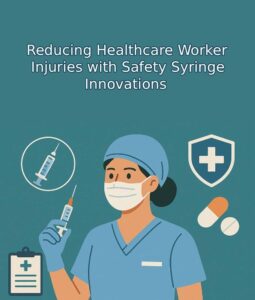In modern diagnostics and clinical testing, the accuracy of blood samples begins with the reliability of the vacuum integrity tube, the sealing power of an airtight blood tube, and the sterility of the sterile collection tube itself. When any of these elements are compromised, sample degradation, inaccurate results, and costly delays can occur. Ensuring optimal tube integrity isn’t just a technical requirement—it’s a core component of patient care, lab safety, and brand reputation.
This guide breaks down the essentials of manufacturing, testing, and maintaining vacuum integrity tube performance to help you design, produce, or source blood collection systems that labs can trust. Know more..
Why Vacuum Integrity Matters
Blood collection tubes rely on vacuum pressure to draw a precise amount of blood into the tube without external suction. This process hinges on two things:
- An airtight blood tube construction to prevent leaks or air exchange.
- A stable internal vacuum calibrated to specific draw volumes.
When the vacuum integrity tube fails, it results in:
- Underfilled or overfilled samples
- Hemolysis or clotting
- Inaccurate test results
- Higher rejection rates
- Loss of trust in the brand
Maintaining a sterile, sealed, and pressurized environment from production to use is mission-critical.
The Core Components of a High-Integrity Collection Tube
To understand how to maintain vacuum integrity, let’s break down the parts of a sterile collection tube and how each can contribute to system failure—or success.
- Tube Barrel
- Made of medical-grade PET or glass
- Must be resistant to breakage and deformation
- Walls must be uniform to hold pressure evenly
- Closure Cap
- Usually a rubber stopper plus plastic cap
- Must fit securely and deform predictably under needle insertion
- Designed to reseal post-use to prevent leakage or biohazard exposure
- Vacuum Seal
- Pre-measured vacuum drawn and sealed during production
- Sensitive to microleaks, altitude shifts, and time-related pressure loss
- Additive Layer
- Anticoagulants or separation gels must be evenly distributed
- Improper coating may interfere with vacuum function
When all components align, you get a true vacuum integrity tube—reliable, sealed, and lab-ready.
Manufacturing Best Practices for Vacuum Integrity
Creating a truly airtight blood tube requires precision. Here’s how top manufacturers get it right:
1. Vacuum Calibration During Production
- Precise machinery is used to draw air out and set exact vacuum levels.
- Automated stations measure internal pressure and verify against specifications.
- Tubes are rejected if vacuum pressure is off by even a small margin.
2. Material Selection
- PET tubes must be stress-tested for wall consistency.
- Rubber stoppers should meet compression and elasticity standards to maintain vacuum under repeated needle punctures.
3. Sterile Sealing
- A sterile collection tube isn’t truly secure unless it’s sealed in a Class 100 cleanroom.
- Packaging must protect from microbial intrusion and physical stress.
4. Inline Quality Assurance
- Each tube undergoes vacuum leak detection.
- Inline pressure sensors and airflow analysis help detect microfissures or deformation.
- Tubes are visually and mechanically inspected for cracks, seal weaknesses, or deformities.
Key Vacuum Integrity Testing Methods
To guarantee vacuum performance and airtight blood tube quality, manufacturers run multiple tests:
1. Altitude Simulation Test
- Simulates pressure changes during air transport.
- Ensures the vacuum integrity tube doesn’t burst, leak, or depressurize at altitude.
2. Helium Leak Test
- High-sensitivity test using helium as a tracer gas.
- Measures minute leaks in the tube structure or stopper seal.
3. Submersion and Dye Test
- Tubes are submerged and subjected to vacuum pressure with dye exposure.
- Bubbles or dye intrusion indicates seal compromise.
4. Shelf-Life Simulation
- Tubes are aged under accelerated environmental conditions.
- Checks whether the sterile collection tube maintains vacuum integrity over time.
Common Causes of Vacuum Loss in Blood Collection Tubes
Vacuum failure can originate from several avoidable sources:
- Microcracks in tube walls due to inconsistent cooling or manufacturing defects
- Improper stopper design—e.g., too soft or misaligned during insertion
- Packaging issues allowing moisture or heat exposure during transport
- Altitude or temperature shifts during logistics phases
Regular audits and testing are critical for early detection.
Packaging & Logistics: Hidden Risk Factors
Even a perfectly built vacuum integrity tube can lose its vacuum if not handled correctly.
- Shock-absorbent packaging protects against tube deformation during transit.
- Humidity control reduces rubber degradation and additive degradation.
- Batch tracking systems help isolate compromised product quickly in case of failure reports.
Pro tip: Always mark production lot, vacuum level, expiration date, and storage temperature on your airtight blood tube packaging.
How to Choose the Right OEM Partner for Blood Collection Tubes
If you’re outsourcing your sterile collection tube production or looking for OEM partners, use this checklist:
- ISO 13485 Certification for medical device production
- Documented vacuum testing protocols
- Real-time QC data from production line
- Proof of pressure stability over product lifespan
- Experience with Class II medical devices
- Customization capabilities for draw volume, additives, branding
An experienced OEM will help you maintain quality standards while scaling your brand with confidence.
Compliance Considerations for Vacuum-Sealed Blood Tubes
Maintaining a compliant vacuum integrity tube involves meeting several regulatory benchmarks:
- FDA 21 CFR 820.30 (Design Control)
- ISO 13485 for QMS compliance
- U MDR / IVDR standards for European distribution
- Sterility assurance levels (SAL 10^-6) for patient safety
- CE marking requirements for vacuum-sealed class A devices
Remember: failure in vacuum integrity isn’t just a defect—it’s a legal and clinical liability.
The Role of End-User Training
Often overlooked, proper training of healthcare professionals can preserve the integrity of the airtight blood tube right to the point of use.
Tips:
- Avoid puncturing the rubber cap multiple times
- Store tubes within recommended temperature ranges (typically 4–25°C)
- Always check vacuum draw and expiration before use
- Use compatible blood collection needles to avoid stopper tearing
Create simple infographics and quick-start guides to distribute with your sterile collection tube shipments.
Monitoring & Quality Control Post-Market
Quality assurance doesn’t stop after the tubes leave the warehouse. Monitoring post-market performance is critical.
- Track user complaints related to underfilled tubes or resistance during draw
- Conduct periodic field vacuum tests
- Issue batch recalls proactively when thresholds are breached
- Integrate digital tracking (QR code + lot #) for real-time feedback collection
Building a feedback loop reinforces trust and drives continuous improvement.
Innovations in Vacuum Tube Technology
Next-gen developments in vacuum integrity tube design are focused on:
- Smart RFID-enabled tubes to track usage and expiration
- Auto-sealing stoppers to prevent leakage post-draw
- Greener plastics for sustainable single-use
- Pressure-indicator caps that verify vacuum levels at time of use
Stay competitive by aligning your brand with these trends.
Conclusion: Don’t Compromise on Vacuum Integrity
Whether you’re a manufacturer, OEM buyer, or healthcare brand, the reliability of your vacuum integrity tube, the seal of your airtight blood tube, and the sterility of your sterile collection tube form the foundation of diagnostic confidence.
From material sourcing and quality control to testing, packaging, and training—every detail counts. By following best practices and partnering with experienced suppliers, you’ll ensure every blood sample collected is safe, accurate, and trusted.
Article Recap – Key Takeaways
| Topic | Summary |
| Why vacuum matters | Prevents sample errors, ensures accurate test results |
| Tube components | Barrel, stopper, vacuum seal, additives |
| Manufacturing tips | Vacuum calibration, sterility, quality control |
| Testing methods | Helium leak, submersion, shelf-life simulation |
| Failure risks | Cracks, stopper defects, poor logistics |
| OEM checklist | Look for ISO, testing, traceability |
| End-user role | Training, storage, handling practices |
| Future trends | RFID, pressure sensors, eco materials |
Want Help Sourcing the Perfect Tube?
Let our team guide you in designing or sourcing the highest quality vacuum integrity tube systems available. Whether it’s OEM, custom branding, or logistics support—we’re ready.
Contact us now to get expert consultation and product samples.






